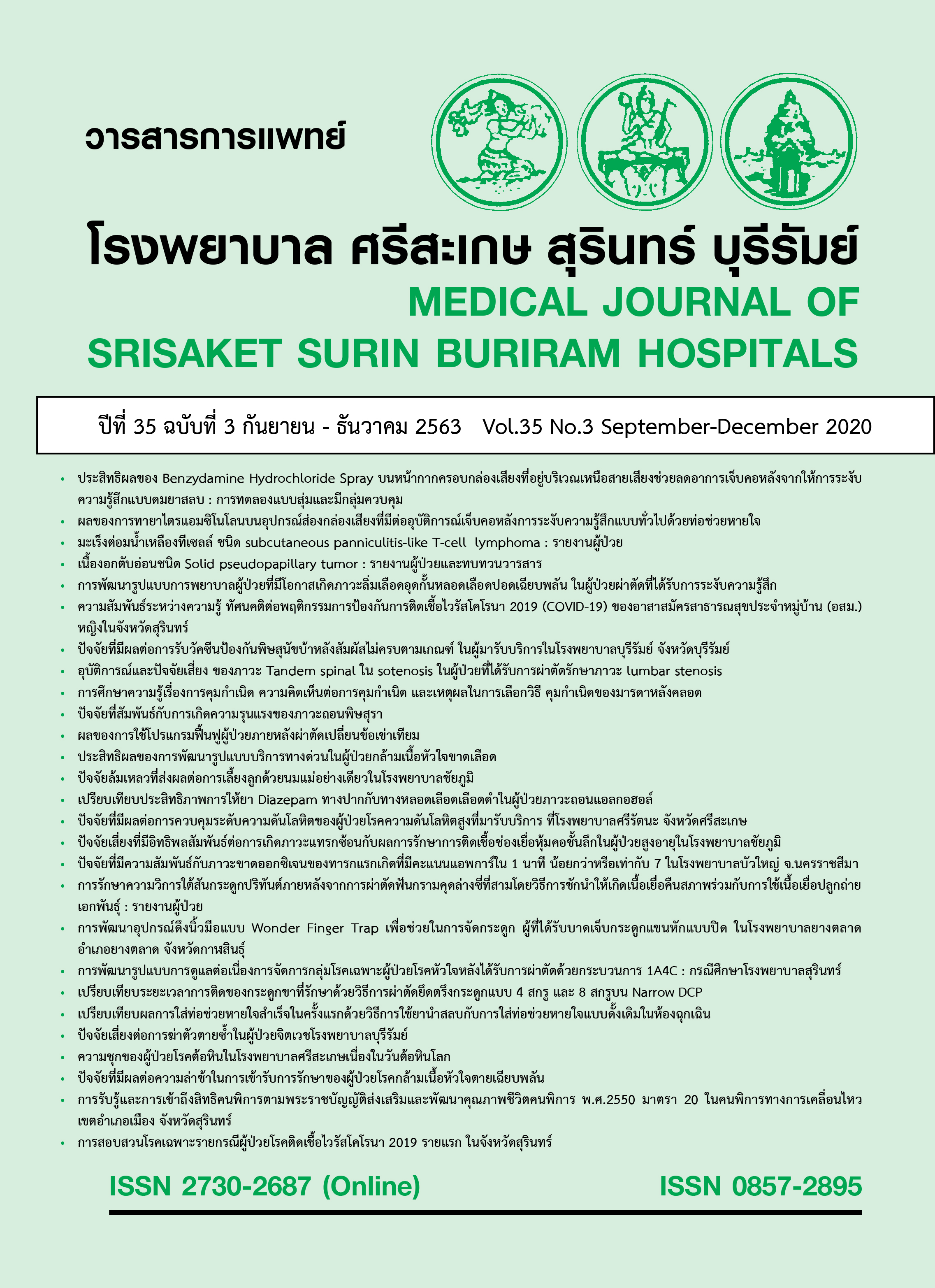เปรียบเทียบผลการใส่ท่อช่วยหายใจสำเร็จในครั้งแรก ด้วยวิธีการใช้ยานำสลบกับการใส่ท่อช่วยหายใจแบบดั้งเดิมในห้องฉุกเฉิน
Main Article Content
บทคัดย่อ
หลักการและเหตุผล: การใส่ท่อช่วยหายใจเป็นหัตถการสำคัญในการช่วยเหลือผู้ป่วยที่มีภาวะหายใจล้มเหลว การใส่ท่อช่วยหายใจได้สำเร็จอย่างรวดเร็ว มีผลต่อการรักษาผู้ป่วยและลดภาวะแทรกซ้อนที่เกิดจากภาวะหายใจล้มเหลว ปัจจุบันการใส่ท่อช่วยหายใจด้วยวิธีนำสลบ (Rapid Sequence Intubation, RSI) เป็นมาตรฐานในการใส่ท่อช่วยหายใจในห้องฉุกเฉินในระดับสากล ช่วยให้การใส่ท่อช่วยหายใจสำเร็จได้ในครั้งแรก และลดภาวะแทรกซ้อนได้ดีกว่าวิธีดั้งเดิม
วัตถุประสงค์: เปรียบเทียบผลการใส่ท่อช่วยใจสำเร็จในครั้งแรกด้วยวิธีนำสลบ (RSI) กับการใส่ท่อช่วยหายใจด้วยวิธีดั้งเดิมปัจจัยที่มีผลต่อการใส่ท่อช่วยหายใจสำเร็จในครั้งแรก (First-pass intubation) และภาวะแทรกซ้อนที่เกิดขึ้นระหว่างการใส่ท่อช่วยหายใจทั้งสองวิธี
วิธีการศึกษา: เป็นการศึกษา retrospective observational study ในผู้ป่วยที่มีอายุ 15 ปีขึ้นไป ที่ได้รับการใส่ท่อช่วยหายใจที่ห้องฉุกเฉินโรงพยาบาลสุรินทร์ ตั้งแต่วันที่ 1 พฤศจิกายน พ.ศ. 2562 ถึงวันที่ 30 เมษายน พ.ศ. 2563
ผลการศึกษา: มีผู้ได้รับการใส่ท่อช่วยหายใจที่ห้องฉุกเฉินโรงพยาบาลสุรินทร์ทั้งหมด 64 ราย เป็นการใส่ท่อช่วยหายใจด้วยวิธีนำสลบ (RSI) จำนวน 33 ราย คิดเป็นร้อยละ 51.6 เป็นการใส่ท่อช่วยหายใจด้วยวิธีดั้งเดิม 31 ราย คิดเป็นร้อยละ 48.4 ข้อมูลทั่วไปของทั้งสองกลุ่มตัวอย่าง เพศ อายุ รูปร่าง ลักษณะของโรคที่จำเป็นต้องใส่ท่อช่วยหายใจ ความยากง่ายจากการประเมินก่อนใส่ท่อช่วยหายใจ อุปกรณ์ในการใส่ท่อช่วยหายใจ ผู้ทำการใส่ท่อช่วยหายใจ ไม่มีความแตกต่างกันอย่างมีนัยสำคัญ ในผู้ป่วยที่ได้รับการใส่ท่อช่วยหายใจโดยการใช้ยานำสลบ (RSI) เปรียบเทียบกับการใส่ท่อช่วยหายใจด้วยวิธีดั้งเดิม โอกาสในการใส่ท่อช่วยหายใจสำเร็จในครั้งแรกได้ไม่แตกต่างกัน แต่แพทย์เวชศาสตร์ฉุกเฉิน (Emergency Physician) เป็นผู้ใส่ท่อช่วยหายใจ เปรียบเทียบกับนักศึกษาแพทย์ชั้นปีที่ 6 (6th year medical student) เป็นผู้ใส่ท่อช่วยหายใจมีความแตกต่างกันอย่างมีนัยสำคัญในการใส่ท่อช่วยหายใจได้ในครั้งแรก (p=0.021) ภาวะแทรกซ้อนจากการใส่ท่อช่วยหายใจ ได้แก่ ภาวะขาดออกซิเจน (hypoxia) ภาวะความดันโลหิตต่ำ (hypotension) การบาดเจ็บของฟัน (dental trauma) โดยพบว่าวิธีการใช้ยานำสลบ (RSI) พบภาวะขาดออกซิเจน (hypoxia) ภาวะความดันโลหิตต่ำ (hypotension) มากกว่าการใส่ท่อช่วยหายใจด้วยวิธีดั้งเดิมแต่ไม่มีนัยสำคัญทางสถิติ
สรุป: การใส่ท่อช่วยหายใจสำเร็จในครั้งแรกด้วยวิธีใช้ยานำสลบ (RSI) และวิธีดั้งเดิมไม่มีความแตกต่างกันอย่างมีนัยสำคัญ
คำสำคัญ: การใส่ท่อช่วยหายใจด้วยวิธีใช้ยานำสลบ
Article Details
เอกสารอ้างอิง
Grounds RM, Twigley AJ, Carli F, Whitwam JG, Morgan M. The haemodynamic effects of intravenous induction. Comparison of the effects of thiopentone and propofol. Anaesthesia 1985;40(8):735-40.
Okubo M, Gibo K, Hagiwara Y, Nakayama Y, Hasegawa K. The effectiveness of rapid sequence intubation (RSI) versus non-RSI in emergency department: an analysis of multicenter prospective observational study. Int J Emerg Med 2017;10(1):1.
Brown CA 3rd, Bair AE, Pallin DJ, Walls RM. NEAR III Investigators. Techniques, success, and adverse events of emergency department adult intubations Ann Emerg Med 2015;65(4):363-370.e1.
Kim JH, Kim YM, Choi HJ, Je SM, Kim E. Korean Emergency Airway Management Registry (KEAMR) Investigators. Factors associated with successful second and third intubation attempts in the ED. Am J Emerg Med 2013;31(9):1376-81.
Sagarin MJ, Barton ED, Chng YM, Walls RM; National Emergency Airway Registry Investigators. Airway management by US and Canadian emergency medicine residents: a multicenter analysis of more than 6,000 endotracheal intubation attempts. Ann Emerg Med 2005;46(4):328-36.
Sakles JC, Laurin EG, Rantapaa AA, Panacek EA. Airway management in the emergency department : a one-year study of 610 tracheal intubations. Ann Emerg Med 1998;31(3):325-32.
Simpson J, Munro PT, Graham CA. Rapid sequence intubation in the emergency department: 5 year trends. Emerg Med J 2006;23(1):54-6.
Tayal VS, Riggs RW, Marx JA, Tomaszewski CA, Schneider RE. Rapid-sequence intubation at an emergency medicine residency: success rate and adverse events during a two-year period. Acad Emerg Med 1999;6(1):31-7.
Walls RM, Brown CA 3rd, Bair AE, Pallin DJ; NEAR II Investigators. Emergency airway management: a multi-center report of 8937 emergency department intubations. J Emerg Med 2011;41(4):347-54.
Li J, Murphy-Lavoie H, Bugas c, Martinez J, Preston c. Complications of emergency intubation with and without paralysis. Am J Emerg Med 1999;17(2):141-3.
Bozeman WP, Kleiner DM, Fluggett V. A comparison of rapid-sequence intubation and etomidate-only intubation in the prehospital air medical setting. Prehosp Emerg Care 2006;10(1):8-13.
Kim C, Kang HG, Lim TH, Choi BY, Shin YJ, Choi HJ.What factors affect the success rate of the first attempt at endotracheal intubation in emergency, departments? Emerg Med J 2013;30(11):888-92.
Wongyingsinn M, Surabenjawong UA. Prospective Controlled of the Rapid Sequence Intubation Technique in the Emergency Department of a University Hospital. J Med Assoc Thai 2017;100(9):953.
Choi YF, Wong TW, Lau CC, Siu AYC, Lo CB, Yuen MC, et al. A study of Orotracheal Intubation in Emergency Departments of Five District Hospitals in Hong Kong. Hong Kong j emerg Med 2003;10(3):138-45.
สกล เฮดดิการ์ด. การใส่ท่อหายใจในแผนกฉุกเฉิน โรงพยาบาลลำปางและโรงพยาบาลแพร่. ลำปางเวชสาร 2555;33(2):103-14.
Levitan RM, Rosenblatt B, Meiner EM, Reilly PM, Hollander JE. Alternating day emergency medicine and anesthesia resident responsibility for management of the trauma airway: a study of laryngoscopy perfor mance and intubation success. Ann Emerg Med 2004;43(1):48-53.
Barton ED., Swanson ER., Hutton KC. Success and failure rates of rapid sequence intubation versus non-rapid sequence intubation by air medical providers in 2,853 patients. Ann Emerg Med 2004;44(4S):S65.
Falcone RE, Herron H, Dean B, Werman H. Emergency scene endotracheal intubation before and after the introduction of a rapid sequence induction protocol. Air Med J 1996;15(4):163-7.
ภุมรินทร์ แซ่ลิ่ม, ประสิทธิ์ วุฒิสุทธิเมธาวี, วีรัตน์ วศินวงศ์. การศึกษานำร่อง เปรียบเทียบวิธีใส่ท่อทางเดินหายใจ แบบรวดเร็วโดยใช้ยานำสลบและยาคลายกล้ามเนื้อ กับวิธีใส่ท่อทางเดินหายใจ แบบไม่ใช้ยาคลายกล้ามเนื้อ ในแผนกฉุกเฉิน โรงพยาบาลสงขลานครินทร์. สงขลานครินทร์เวชสาร 2553;28(6):317-27.
Lin CC, Chen KF, Shih CP, Seak A, Hsu KH. The prognostic factors of hypotension after rapid sequence intubation. Am J Emerg Med 2008;26(8):845-51.


